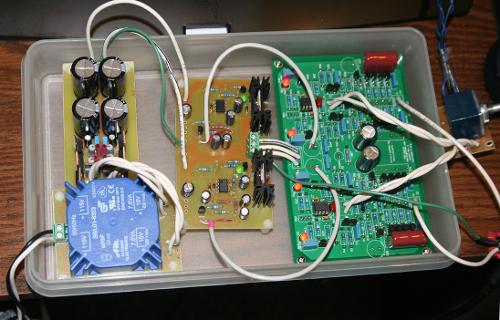Quote:
What kind of horrible things will have to be endured with a gain of x11 and Grado's?
What happens if said user upgrades to a higher impedance headphone?
Why was the Dynalo designed with a 20K pot in mind, and a gain of x11 times?
Is 5x ok with music that's brick walled? or rather more music with dynamic range?
This has to be somewhat confusing to someone? Namely the 3rd question.
Cheers
1: You (generally) attenuate a LOT which puts you in a poorly matched section of the pot, and IME screws with frequency response a bit. Higher gain results in more noise due to funky resistor effects, bummer. The only advantage is that the volume control is WAY down, like you are holding back a more powerful amp - purely psychological.
2: The word of the lord passed down in the headphone chapter of the audio bible that you need gain of 11 to run anything more than 75ohms will have to be broken then. Obviously Im making a cheap joke. The lord did not come down and give us this rule, a human being (who like all human beings is prone to errors, and unlike many human beings listens loud as hell with 600ohm headphones) pawned it off on us - the rule may even predate people listening to headphones for hifi! gain of 10 was VERY popular for preamps, despite the fact that power amps have been running with 1v input sensativity since the 60's or earlier. Anyways, Despite what the easy to follow rule tells us, high impedance headphones generally run just fine on amps with voltage gain in the 1-4 ranges. Try it! Some people MAY top it out, but then gain of 11 is only a little more than 3 (if you max out an amp with gain of 3 easily, 11 is not even enough!). If the volume knob NEVER gets within 1/3 of the max you have more gain than you need - save yourself some resistor noise, and reduce the gain.
3: Why a 20K pot? If Im not mistaken Kevin Gilmore had a Penny + Gilles 20K pot "just sitting around" waiting for an application... Good enough reason to use a $250 pot for me.
Many MFR's make 20-25K audio pots, its just that nobody uses them*. EVER. P+G is awesome so they can do anything they want.
* another rule given us by the good lord in the general section of the audio bible is that the only values of potentiometer to use as attenuators are 10K, 50K, and 100K. Values below 10K, or between those 3 values must never be used as an attenuator least you be smitten. In all seriousness, 20K is a sweet value: Its a LITTLE bit more than 10K (twice as much!) which buys you an extra octave of bass in cap coupled sources, but not so high impedance as to cause undue noise. 50&100K ohm pots have much more inherent noise which coupled with the trend for too much gain gets you nothing but too much noise * too much gain! values lower than 10K (1K,2K,5K are common) are SWEEEET because they have VERY low noise, but may prove too difficult for some sources to drive well, and forget it with cap coupled sources.
Quote:
No idea why it was originally designed with an 11x gain. 5x should be fine with most music, though you may not get a huge volume travel with high sensitivity headphones. Nothing horrible would be endured, but you would only be able to turn the knob like 5% to get loud volume.
EVERYTHING was designed for 11X gain back then.
Quote:
This is blowing my extremely tired mind. Also, the way the pot is wired in this confuses me, but I'll figure it out tomorrow after sleep.
poosticks... the quote in a quote thing didnt work. Just immagine the part you quoted just before the part I quoted is there.
Everyone talks about gain without consideration of the source voltage level, ASSUMING that the user has a "standard" 2v source. Some people have high output 4 or 10v sources, others have a very low 0.25v. With a 4 or 10v source you need NO gain to run almost anything - just a good stiff buffer that can handle the heat. With a 0.25v source you actually need gain to run 300 ohm headphones!





